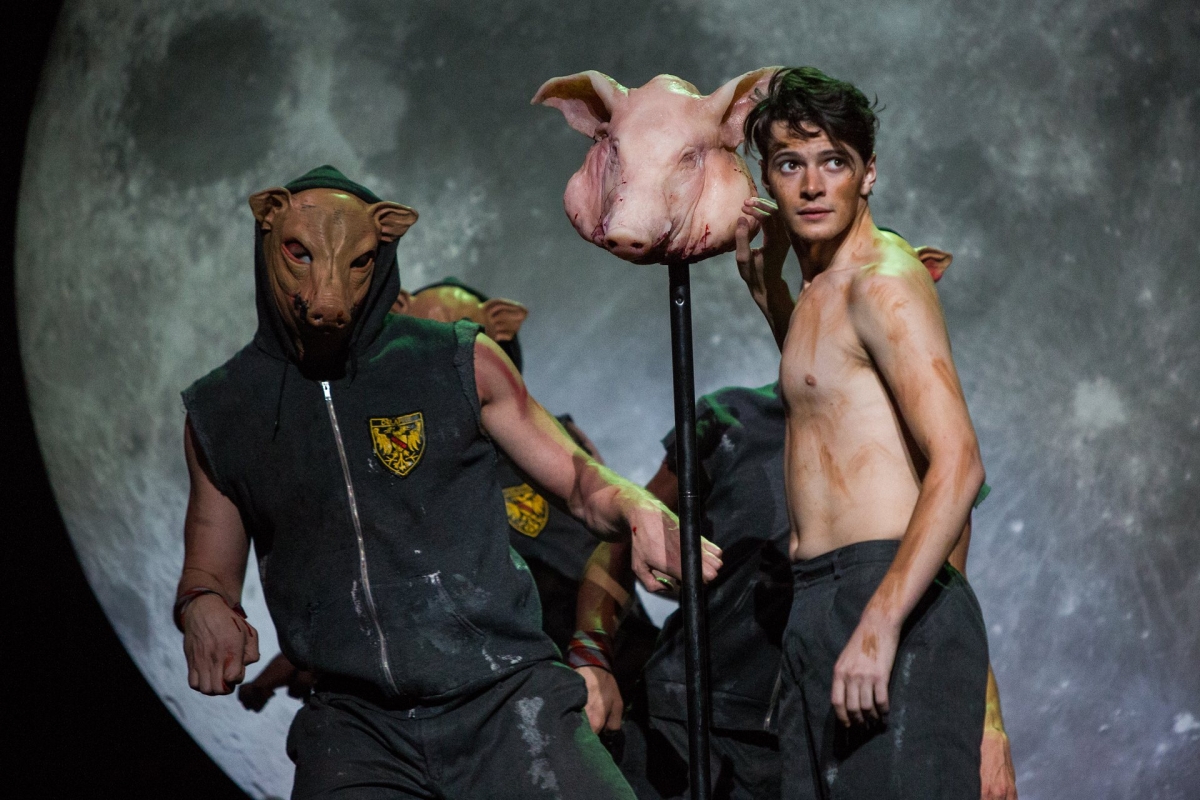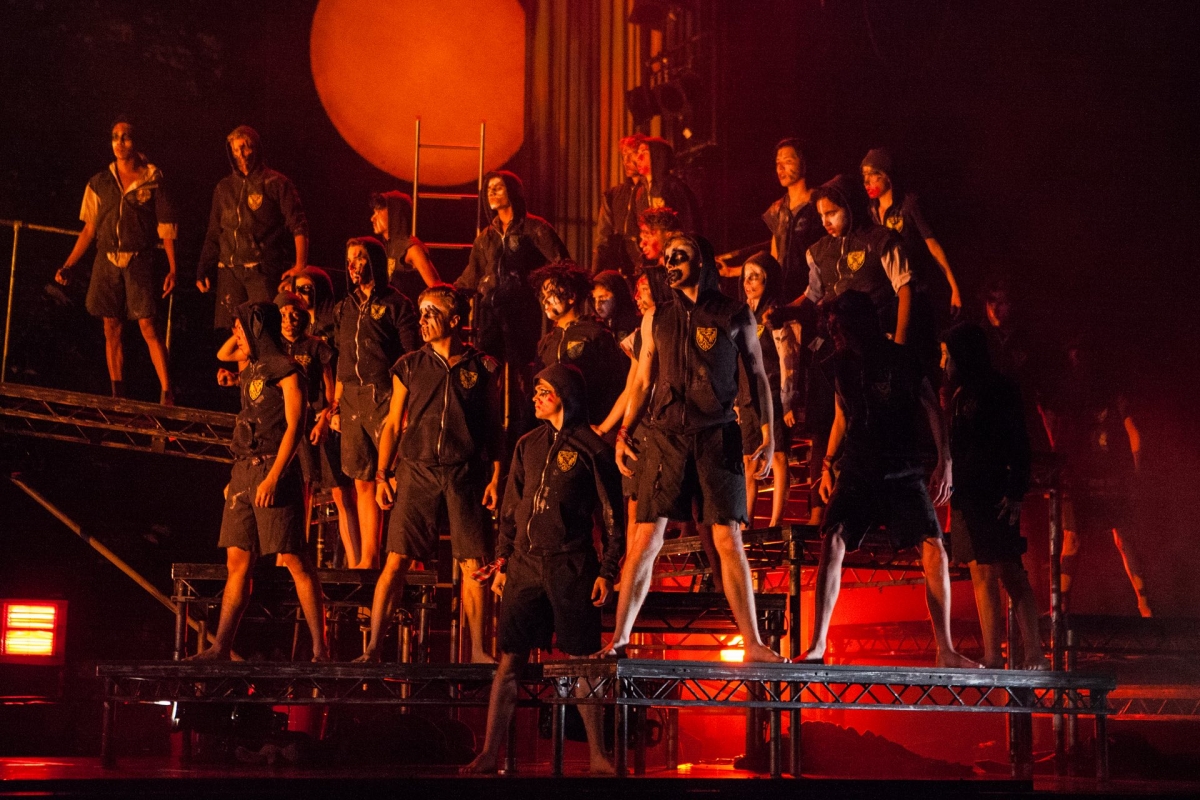British contemporary dance sensation Matthew Bourne is best known for daring but accessible adaptations of familiar works, from Swan Lake to Edward Scissorhands. His take on Williams Golding’s 1954 dystopian novel Lord of the Flies confirms that reputation. In this Australian premiere, and the first performance outside the UK, a cast of young male dancers, both amateur and professional, delivered an energetic and mostly convincing interpretation of an unsupervised group of schoolboys’ descent into anarchy.
In this production directed by Bourne, the setting is not Golding’s tropical island but a theatre, abandoned in what appears to be the aftermath of war. This single set, designed by Lez Brotherston, is a dim, cavernous space with ascending platforms stage left. With increasing vigour as their characters shift from civility to savagery, the dancers literally bounced off these platforms, and dynamically interacted with backstage clutter such as oil drums, poles and wheeled racks of coats.
 Sir Matthew Bourne’s Lord of the Flies. Photos © Mark Gambino
Sir Matthew Bourne’s Lord of the Flies. Photos © Mark Gambino
Just as Brotherston’s costumes devolved from neat to tattered school uniforms and ultimately a tribal look heightened by face paint, Scott Ambler’s choreography left no doubt about the boys’ transformation. The dancers initially moved in disciplined formation, with a martial feel that suggested they were being raised as future soldiers (for the socially condoned form of barbarity the novel alludes to more strongly).
Soon revelling in their freedom, individuals rushed about in a freewheeling dance inspired by boyish fun – playing soccer, and pretending to be planes, for example. Senior boy Ralph calls for order, but Jack, a big lad eyeing his chance for hedonism and power, confronts him, and the choreography’s shift toward aggressive physicality – from food fight to fist fight and murder – begins.
This was expressed in diverse ways, from leaps, spins and duets rooted in ballet, to movement inspired by indigenous ceremonial dance, acrobatics and parkour. There was even a striking cinematic effect reminiscent of Guy Ritchie’s films: during a couple of dramatic moments, the dancers moved in slow motion under stark lighting, then suddenly shifted back to full speed. Atmospheric lighting was a feature throughout the performance.
 Bourne’s Lord of the Flies brings together professional and amateur dancers.
Bourne’s Lord of the Flies brings together professional and amateur dancers.
The principal dancers strongly conveyed character, particularly Daniel Wright as the physically ferocious Jack, Dominic North as noble then reluctant leader Ralph, and Luke Murphy, who brought compelling awkwardness to the role of bespectacled asthmatic, Piggy.
The supporting cast were local amateurs mostly aged between 10 and 17. Many had no background in theatre let alone dance before this production came to town, but they created such massed energy, both raw and disciplined, that Lord of the Flies would be greatly diminished without them.
The altered setting immediately signalled this production’s intention to diverge from Golding, but many key elements were apparent. The conch shell that represents democracy in the novel is a drumstick in Bourne’s adaptation. This prop became a powerful focal point as the dancers willingly gave, protected, reluctantly received or wrested control of it.
The novel’s pig hunt is cleverly reinterpreted, making it clear that this is a perilous environment for child and beast alike. One of the youngest boys, wearing cute pig ears and snout, was chased in what appeared to be a nasty episode of bullying, before it became clear that this dancer actually represented a pig, which was brutally killed by the mob.
Some elements were somewhat lost in translation, however, most notably the novel’s fallen airman being reinterpreted as a vagrant. The boys’ belief that the mysterious stranger is a dangerous monster was strangely muted here, overwhelmed by the dreamlike, inexplicable transformation of Simon (a lithe Patrick Weir) into the vagrant.
An eclectic mix, from angelic choir to minimalist electronica and fulsome tribal drumming, Terry Davies’ score enhanced the mood, albeit with little subtlety at times. Unfortunately, the recording was sometimes loud enough to cause discomfort (at least where I was seated) and often mildly distorted.
Overall, however, Lord of the Flies is energetic, intriguing and accessible contemporary dance, which ably conveys a loss of innocence and the notion that humanity may be savage at heart.
Lord of the Flies is at Arts Centre Melbourne until April 9











Comments
Log in to join the conversation.